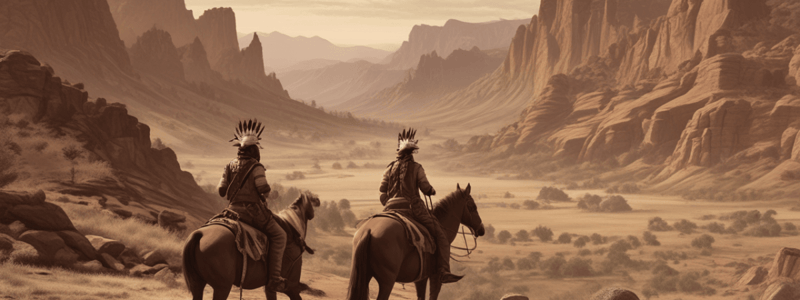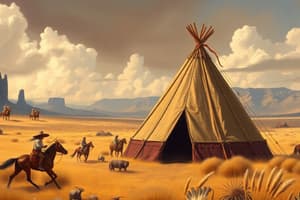Podcast
Questions and Answers
What was Andrew Jackson's stance on central banking?
What was Andrew Jackson's stance on central banking?
- Unaware
- Neutral
- Strong supporter
- Sworn enemy (correct)
What was the result of Andrew Jackson's policies towards the Bank of the United States?
What was the result of Andrew Jackson's policies towards the Bank of the United States?
- Establishment of the Federal Reserve
- Monetary centralization
- Increased national debt
- Liquidation of monetary regulation (correct)
How many local currencies were circulating in the United States on the eve of the Civil War?
How many local currencies were circulating in the United States on the eve of the Civil War?
- 7,000 (correct)
- 100
- 10,000
- 1,000
What was established in 1913 as the successor to the Bank of the United States?
What was established in 1913 as the successor to the Bank of the United States?
Why does Andrew Jackson's face appear on the $20 bill?
Why does Andrew Jackson's face appear on the $20 bill?
What was Andrew Jackson's stance on financial oligarchs?
What was Andrew Jackson's stance on financial oligarchs?
Who did Andrew Jackson defeat in a political dispute?
Who did Andrew Jackson defeat in a political dispute?
What was the doctrine advocated by John Calhoun?
What was the doctrine advocated by John Calhoun?
What was the tone of the Native Americans during the Choctaw removals in Memphis, Tennessee in 1831?
What was the tone of the Native Americans during the Choctaw removals in Memphis, Tennessee in 1831?
What was the main reason why the Choctaws were leaving their country according to the Native American who spoke English?
What was the main reason why the Choctaws were leaving their country according to the Native American who spoke English?
What is the collective term used to refer to the Lakota, Nakota, and Dakota nations?
What is the collective term used to refer to the Lakota, Nakota, and Dakota nations?
What is the original meaning of the word 'Sioux'?
What is the original meaning of the word 'Sioux'?
What was recognized by the Treaty of Fort Laramie in 1851?
What was recognized by the Treaty of Fort Laramie in 1851?
What did the United States bind themselves to do in the Treaty of Fort Laramie?
What did the United States bind themselves to do in the Treaty of Fort Laramie?
What was the result of the Treaty of Fort Laramie's violation by the United States?
What was the result of the Treaty of Fort Laramie's violation by the United States?
What was the deadline for Lakota people to settle on reservations?
What was the deadline for Lakota people to settle on reservations?
What is the name of the region that covers parts of present-day North Dakota, South Dakota, Montana, Wyoming, Nebraska, and Colorado?
What is the name of the region that covers parts of present-day North Dakota, South Dakota, Montana, Wyoming, Nebraska, and Colorado?
Who was the commander of the Sioux during the Battle of Rosebud?
Who was the commander of the Sioux during the Battle of Rosebud?
What was the ratio of Sioux to U.S. troops during the Battle of Rosebud?
What was the ratio of Sioux to U.S. troops during the Battle of Rosebud?
What was the outcome of the Battle of Rosebud?
What was the outcome of the Battle of Rosebud?
Who led the Seventh Cavalry into the Black Hills during the Battle of Little Big Horn?
Who led the Seventh Cavalry into the Black Hills during the Battle of Little Big Horn?
What was the purpose of Lieutenant Colonel George Armstrong Custer's mission?
What was the purpose of Lieutenant Colonel George Armstrong Custer's mission?
What was the outcome of the Battle of Little Big Horn?
What was the outcome of the Battle of Little Big Horn?
What was the title of Sitting Bull besides being a holy man?
What was the title of Sitting Bull besides being a holy man?
What has been developed by Americans in the last decade or so regarding the treatment of Indians?
What has been developed by Americans in the last decade or so regarding the treatment of Indians?
What is Dee Brown attempting to do with his work?
What is Dee Brown attempting to do with his work?
What is the title of the book written by Dee Brown?
What is the title of the book written by Dee Brown?
Who directed the Western film Unforgiven (1992)?
Who directed the Western film Unforgiven (1992)?
What is the title of the Western film that prefigured Kevin Costner's Dances With Wolves (1990)?
What is the title of the Western film that prefigured Kevin Costner's Dances With Wolves (1990)?
What is the title of the novel that inspired Anthony Mann's The Furies?
What is the title of the novel that inspired Anthony Mann's The Furies?
Who directed the Western films Stage Coach (1939), She Wore a Yellow Ribbon (1949), and The Searchers (1956)?
Who directed the Western films Stage Coach (1939), She Wore a Yellow Ribbon (1949), and The Searchers (1956)?
What was the result of the revival of the Western genre in the early 1990s?
What was the result of the revival of the Western genre in the early 1990s?
What was the outcome of the Lyng v. Northwest Indian Cemetery Protective Association case?
What was the outcome of the Lyng v. Northwest Indian Cemetery Protective Association case?
Why did the court rule that religious freedom cases should be deferred to legislative matters?
Why did the court rule that religious freedom cases should be deferred to legislative matters?
What was compromised by the Lyng v. Northwest Indian Cemetery Protective Association ruling?
What was compromised by the Lyng v. Northwest Indian Cemetery Protective Association ruling?
What is one consequence of the Lyng v. Northwest Indian Cemetery Protective Association ruling?
What is one consequence of the Lyng v. Northwest Indian Cemetery Protective Association ruling?
Where are many Native American artifacts currently located?
Where are many Native American artifacts currently located?
What event occurred in 1803 that affected the territory of the Plains Indians?
What event occurred in 1803 that affected the territory of the Plains Indians?
What was the context in which French explorers, missionaries, and traders encountered the Plains Indians?
What was the context in which French explorers, missionaries, and traders encountered the Plains Indians?
What was the goal of the Lewis and Clark expedition?
What was the goal of the Lewis and Clark expedition?
Flashcards are hidden until you start studying
Study Notes
Andrew Jackson and American Banking
- Andrew Jackson was a sworn enemy of paper currency and central banking, referring to the Bank of the United States as the "Monster".
- He vetoed the renewal of the Bank's charter in 1832 and ran for reelection as the champion of "People v. Monster".
- This led to the liquidation of monetary regulation in the United States and ensuing monetary decentralization.
- The result was an epidemic of counterfeiting, with 7,000 local currencies circulating in the United States by the eve of the Civil War.
- It took President Lincoln's Banking Act of 1862 to restore monetary order.
Andrew Jackson and Native Americans
- Jackson was a staunch defender of the Union and offered himself as a friend of the common man, unwilling to see the country dominated by financial oligarchs.
- He defeated John Calhoun, who advocated for the doctrine of "nullification", which would allow a state to deny the validity of a federal law.
- Jackson broke with Calhoun and ultimately marginalized him.
The Removal of Native Americans
- The Choctaw removals in Memphis, Tennessee in 1831 were described by Tocqueville as a scene of "ruin and destruction", with the Indians being "somber and taciturn".
- The Black Hills region of the United States covers parts of North Dakota, South Dakota, Montana, Wyoming, Nebraska, and Colorado, and is home to the Lakota, Nakota, and Dakota nations.
- The Treaty of Fort Laramie in 1851 recognized Sioux territory, but the United States soon violated the treaty, leading to a series of wars and skirmishes.
Battles with Native Americans
- In 1876, the battles of Rosebud and Little Big Horn took place, with the Sioux, led by Sitting Bull and Crazy Horse, refusing to comply with US commands to confine themselves to reservations.
- Brigadier General George Crook's troops were largely outnumbered and suffered numerous casualties, leading to a withdrawal.
- Lieutenant Colonel George Armstrong Custer's battalion was overwhelmed by the Sioux, resulting in the deaths of his entire battalion of 200 men.
The Legacy of Native American Treatment
- The treatment of Native Americans has been marked by injustice, with the US government violating treaties and engaging in discriminatory policies.
- The Western film genre revived in the early 1990s, with films like Clint Eastwood's Unforgiven (1992) portraying the lawman behaving as badly as the renegade.
- The Lyng v. Northwest Indian Cemetery Protective Association (1988) ruling compromised the trust relationship between the federal government and Native American tribes, undermining religious freedom and treaty relations.
Studying That Suits You
Use AI to generate personalized quizzes and flashcards to suit your learning preferences.




